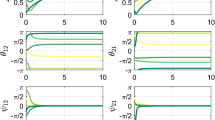Abstract
We analyze spatio-temporal dynamics of coupled neural oscillatory arrays. The interconnected oscillators can produce a wide range of dynamics, including quasi-periodic limit cycles, chaotic waveforms, and intermittent chaotic oscillations. We study the role of distributed input bias and develop methods for learning the input patterns. After learning, the coupled oscillators produce large-scale synchronized, narrow-band oscillations in response to the learned patterns. We study patterns of amplitude modulations that span the whole lattice graph. The presented results correspond to Freeman’s 6th building block of neurodynamics.








Similar content being viewed by others
References
Aertsen A, Erb M, Palm G. Dynamics of functional coupling in the cerebral cortex: an attempt at a model-based interpretation. Physica D Nonlinear Phenomena 1994;75(1–3);103–128.
Aradi I, Barna G, Erdi P. Chaos and learning in the olfactory bulb. Int J Intell Syst. 1995;10:89.
Binder K. Finite size scaling analysis of Ising model block distribution functions. Zeitschrift fur Physik B Condens Matter 1981;43(2):119–140.
Freeman WJ. Mass action in the nervous system. New York: Academic Press; 1975.
Freeman WJ. Simulation of chaotic EEG patterns with a dynamic model of the olfactory system. Biol Cybern 1987;56(2–3):139–150.
Freeman WJ. How brains make up their minds. London: Weidenfeld and Nicolson; 1999.
Hebb DO. The organization of behaviour. New York: Wiley; 1949.
Kaneko K, Tsuda I. Complex systems: chaos and beyond. A constructive approach with applications in life sciences. Berlin: Springer; 2001.
Korn H, Faure P. Is there chaos in the brain? ii. Experimental evidence and related models. CR Biol 2003;326(9):787–840.
Kozma R, Freeman WJ. Chaotic resonance—methods and applications for robust classification of noisy and variable patterns. Int J Bifurc Chaos 2001;11(6):1607–1629.
Kozma R, Puljic M, Balister P, Bollobás B, Freeman WJ. Neuropercolation: A random cellular automata approach to spatio-temporal neurodynamics. Lect Notes Comput Sci 2004;3305:435–443.
Kozma R, Puljic M, Bollobás B, Balister PN, Freeman WJ. Phase transitions in the neuropercolation model of neural populations with mixed local and non-local interactions. Biol Cybern 2005;92(6):367–379.
Makowiec D. Stationary states of toom cellular automata in simulations. Phys Rev E 1999;60(4):3787–3796.
Puljic M, Kozma R. Narrow-band oscillations in probabilistic cellular automata. Phys Rev E 2008;78(026214):6.
Puljic M, Kozma R. Broad-band oscillations by probabilistic cellular automata. J Cell Automata 2010;5(6);491–507.
Acknowledgments
This work is supported in part by Defense Advanced Research Projects Agency (DARPA) Physical Intelligence Program in an HRL subcontract and by Air Force Office of Scientific Research (AFOSR) in the Mathematics and Cognition Program.
Author information
Authors and Affiliations
Corresponding author
Rights and permissions
About this article
Cite this article
Kozma, R., Puljic, M. Learning Effects in Coupled Arrays of Cellular Neural Oscillators. Cogn Comput 5, 164–169 (2013). https://doi.org/10.1007/s12559-012-9182-z
Received:
Accepted:
Published:
Issue Date:
DOI: https://doi.org/10.1007/s12559-012-9182-z




